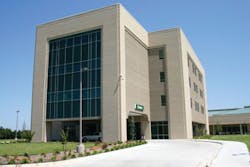There is more video being captured by surveillance cameras than ever before. As the amount of recorded video increases, traditional storage options are reaching their limitations. NVRs and DVRs with local storage options provide a fixed amount of capacity. Since video streams and user needs change over time, it makes it challenging for an integrator to determine what capacity to specify since the amount of storage depends on an estimate of resolution, frame rate, compression and motion detection by camera type. It is a complicated equation that does not offer a truly accurate answer.
Muskogee Community Hospital in Muskogee, Okla., is an example of a customer that had strict storage requirements. The hospital anticipated that its storage needs would increase as the hospital grew and therefore, required a solution that could be easily expandable. It also desired a highly reliable and scalable platform that offered high availability storage. In addition, the hospital wanted to maximize return on investment (ROI) and reduce energy costs due to its commitment to the Leadership in Energy and Environmental Design (LEED) principles.
Josh Herron, president of Digi Surveillance Systems, Pryor, Okla., specified a video surveillance system for Muskogee Community Hospital that leveraged Pivot3 Serverless Computing. Serverless Computing introduces a storage-centric approach where server applications share storage hardware resources to reduce overall power and cooling. Initially purchased to store video from security cameras, Muskogee found it had extra storage space available and allocated the Pivot3 platform to backup its Exchange and file servers and serve as a host for a clinical imaging system. This further demonstrated Muskogee's environmental credentials in its data center by finding a way to double up key technology elements to lower costs, cut energy consumption and at the same time increase efficiency. Leveraging the same platform, the hospital reduced power and cooling costs by up to 40 percent over alternatives that require unique physical servers.
Savings from the start
The savings from the video surveillance system started even before the hospital opened for business. As is typical for major building projects, the hospital owners planned to lease security cameras to safeguard the site during construction. Rather than paying the typical $3,000 per month to rent the gear, the hospital followed Herron's advice and purchased higher quality cameras for construction monitoring and then incorporated that equipment into the hospital's security system. By purchasing the equipment outright, Muskogee received superior surveillance coverage during construction and took $30,000 off the final bill for the video surveillance system.
Once construction finished, the cameras became part of the hospital's 75-camera video surveillance system. This solution specified by Digi Surveillance Systems incorporates a mixture of digital and analog cameras including Avigilon HD cameras with remote PTZ control and three Pivot3 CloudBank appliances. The CloudBank provides five weeks of storage of video surveillance feeds from the cameras. The hospital uses three terabytes of disk space for server backup, while an additional three terabytes are used for image storage for a colon imaging application. The Digi Surveillance team networked the cameras on the corporate network using VLAN connections to one of the two networking closets where they connect to specific switches within the blade enclosures. Since the hospital already had power over Ethernet (PoE), this was used to provide electricity for the IP cameras. For wide areas such as parking lots, Digi Surveillance deployed five megapixel PTZ units while lower cost analog cameras wired back to video encoders are used to cover small doors. Together, all the cameras generate approximately 200 Mbps of network traffic but since there is a 10 Gbps connection between the two network closets, they have no effect on the other enterprise applications.
With most storage units, Herron would set up arrays that span the drives on a single unit, but with Pivot3, the redundancy is created across all the drives and appliances. There is also the aggregate throughput of all the appliances, allowing the potential for more information to be written simultaneously.
Plenty of space
Three CloudBank appliances were initially installed at the hospital to provide five weeks of storage of video surveillance feeds from the cameras but that left plenty of space remaining on the drives unutilized. To begin with, the hospital used 3TB of disk space for server backup, initially using the NTBackup command in Windows Server for basic user file data and then CA ARCServe Backup for the open files that require agents such as SQL Server and Exchange. The automated disk-based backup on the Pivot3 array is more convenient for the IT staff than having to change tapes.
Muskogee Community Hospital then took advantage of serverless computing features to host Windows and Linux servers right on the storage array. This eliminates the expense of purchasing, installing, powering and cooling additional pieces of hardware. In addition, the servers have the same redundant reliability as the data stored on the array. Muskogee tested this with the medical imaging application and after experiencing the benefits, now plans on adding more virtual servers to the array with the assistance of the experienced team at Digi Surveillance Systems.
Lee Caswell is the founder and chief marketing officer of Pivot3 in Palo Alto, Calif.
